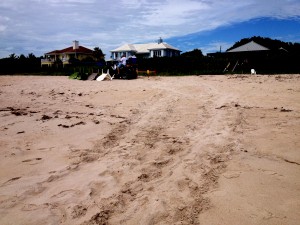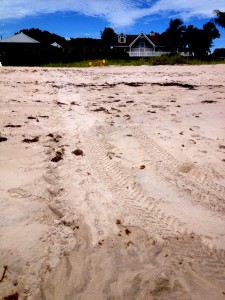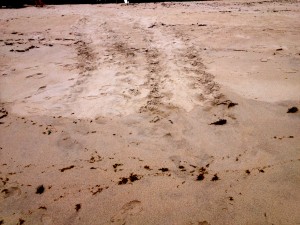As Cheshire mentioned, I’m visiting my dad for his birthday (HAPPY BIRTHDAY, DAD!).
 He lives in Indian River County, Florida, on one of the most active beaches in the world for sea turtle nesting. Today, my brother and I had the great opportunity to watch while Stacy, a volunteer turtle nest monitor, marked two nests, one of a green sea turtle and one of a loggerhead.
He lives in Indian River County, Florida, on one of the most active beaches in the world for sea turtle nesting. Today, my brother and I had the great opportunity to watch while Stacy, a volunteer turtle nest monitor, marked two nests, one of a green sea turtle and one of a loggerhead.
 Stacy told us that green sea turtle mamas walk around on the beach a lot before they choose a spot to lay their eggs. The mama who laid the eggs here went around a dune, came back, went back to the shore, climbed back up the beach and dug two holes before she decided to lay the eggs.
Stacy told us that green sea turtle mamas walk around on the beach a lot before they choose a spot to lay their eggs. The mama who laid the eggs here went around a dune, came back, went back to the shore, climbed back up the beach and dug two holes before she decided to lay the eggs.
Stacy had to dig around a lot before she found the clutch of eggs. She will mark the exact GPS location of this clutch, and the loggerhead clutch a few feet away, for further monitoring. She put orange tape around both clutches.
 Loggerheads are much more direct than green sea turtles. They are also the most common mama turtle here (a few leatherbacks also nest here). This loggerhead mama went up the beach, dug a hole, moved over a little to another hole, and delivered her eggs.
Loggerheads are much more direct than green sea turtles. They are also the most common mama turtle here (a few leatherbacks also nest here). This loggerhead mama went up the beach, dug a hole, moved over a little to another hole, and delivered her eggs.
Stacy had already located the green see turtle eggs, but we watched her look for the loggerhead eggs.
 She dug three holes with her hands to find the eggs, which are about the size of golf balls. Loggerhead eggs aren’t hard like chicken eggs. Stacy showed us what happened when she pushed on the shell, then she pushed on the skin of her hand to give us a point of comparison. (Big thanks to Stacy for taking the picture of the eggs and sending it!)
She dug three holes with her hands to find the eggs, which are about the size of golf balls. Loggerhead eggs aren’t hard like chicken eggs. Stacy showed us what happened when she pushed on the shell, then she pushed on the skin of her hand to give us a point of comparison. (Big thanks to Stacy for taking the picture of the eggs and sending it!)
We have seen about 20 marked turtle nests on our walks in both directions from Dad’s beach access. Of the eggs in the nests, about 70 percent will hatch. The hatchlings will do their best to get to the ocean water, but only about 10 percent of them will survive to adulthood. It’s a good thing mama turtles lay 100-120 eggs per nest and make 4-5 nests per season.
Turtles have some big challenges, including predators, but most importantly, confusing light sources that draw the hatchlings away from the water instead of toward it. Indian River County employs a marine biologist who supervises the sea turtle conservation work. Seven volunteers help monitor the beach, where turtles crawl up the beach about 9,000 times every year to lay their eggs.
Wow – this is so cool to see. Thank you for this. So Momma wanders around looking for a spot? I wonder how she chooses eh? What an amazing thing to see – one of life’s wonders…..